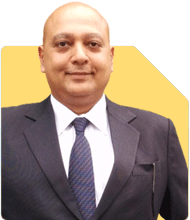I'm 39, earning well, but fear becoming a burden on my son. How can I secure our future?
Ramalingam Kalirajan |8285 Answers |Ask -Follow
Mutual Funds, Financial Planning Expert - Answered on Mar 19, 2025
He has an MBA in finance from the University of Madras and is a certified financial planner.
He is the director and chief financial planner at Holistic Investment, a Chennai-based firm that offers financial planning and wealth management advice.... more

I am 39 years old and my wife is 38 working and my son is 7 years. I earn 35LPA my wife 15LPA. I started with zero as from a young age I took care of my parents by paying tuition and funded by my education. I completed engineering and started paying off my education loan from my first day of work. 2015 I got married and in 2016 we bought our first house. I moved my parents there and I take care of them they are financially dependent on me and I have a 4L health insurance for them. The first house is now worth 55L and I have paid off this loan. We built our 2nd house its worth around 1.2 crore and I have a loan of 70 lakhs left. I have a plot worth 30L which I have bought. I have 40L in MF and stocks, I do SIP of 1Lakh per month ( XIRR was good at 20% but now it's at 13%). I have 20L in gold and 10L in EPF. I have a 1cr term insurance and I do Jeevan umang of 4L per year started last year and Jeevan tarun for my son for 1.5L per year started 2 years ago and I have 40k of Jeevan anand started in 2011 for 25 years. My fear : My parents were dependent on me, and I had nothing to fall back on when I started my career. I do not want to be the same for my son. I want to be financially self-reliant when he starts his career and his life. I want to ensure that he doesn't worry about us when he starts his work life or if he wants to start a business, he has the freedom to do so. I have 15 years left in my career. I want to make sure my wife is also secured if I am not around. My questions is what can I do more to ensure we are financially well off?
You support your parents financially and have Rs. 4L health insurance for them.
Your first house is worth Rs. 55L and is fully paid off.
Your second house is worth Rs. 1.2 crore with a Rs. 70L loan.
You own a plot worth Rs. 30L.
Your investments include Rs. 40L in mutual funds and stocks.
You invest Rs. 1L per month in SIPs.
You have Rs. 20L in gold and Rs. 10L in EPF.
Your term insurance is Rs. 1 crore.
You have investment-linked insurance policies.
Your goal is financial independence for yourself and your family. You want to ensure your son does not have financial burdens when he starts his career.
Strengths in Your Financial Planning
You have built wealth despite challenges.
Your high savings rate helps in wealth accumulation.
Your SIPs give long-term compounding benefits.
Your first home is debt-free, providing stability.
Your gold holdings offer liquidity in emergencies.
Your EPF provides retirement security.
Your term insurance gives financial protection.
Areas That Need Improvement
Your insurance-linked policies are not wealth creators.
Your home loan is a major liability.
Your gold holdings may not generate high returns.
Your current insurance cover may not be enough.
Your parents’ health cover might be inadequate.
Your son’s education and future needs require better planning.
Steps to Strengthen Financial Security
Increase Term Insurance Cover
A Rs. 1 crore cover is low given your income and liabilities.
You should have a cover of at least 15 times your annual income.
Increase your term insurance to Rs. 2.5 crore for full protection.
Ensure your wife has her own term cover as well.
Reassess Your Insurance-Linked Investments
Traditional insurance policies offer low returns.
They do not provide inflation-beating growth.
Surrendering them and shifting to mutual funds is a better option.
This will give higher returns and better flexibility.
Pay Off Your Home Loan Strategically
Your home loan balance of Rs. 70L is a major liability.
Focus on repaying it within the next 5-7 years.
Increasing EMI payments or making part prepayments can help.
Avoid extending the tenure to reduce interest burden.
Optimise Your Mutual Fund Investments
Your SIP of Rs. 1L per month is a strong wealth-building tool.
XIRR of 13% is still a good return for long-term investing.
Ensure your portfolio has a mix of large-cap, flexi-cap, and small-cap funds.
Actively managed funds will help in capturing market opportunities.
Avoid index funds as they limit potential gains.
Strengthen Your Parents’ Health Insurance
Rs. 4L health cover for them may not be enough.
Increase their health insurance to Rs. 10L with a super top-up plan.
This will prevent financial stress in case of medical emergencies.
Plan for Your Son’s Education and Future
Higher education costs are rising rapidly.
Start a dedicated mutual fund portfolio for his education.
Avoid insurance-linked child plans as they offer poor returns.
SIPs in equity funds can provide high returns over 10-15 years.
Ensure flexibility in investments to support his career or business plans.
Secure Your Wife’s Financial Future
Your wife should have her own investments independent of you.
Ensure she has adequate insurance and retirement savings.
Consider joint ownership of assets for financial security.
Encourage her to invest in equity mutual funds for wealth creation.
Retirement Planning and Wealth Creation
You have 15 years left in your career.
Focus on accumulating at least Rs. 10-12 crore for retirement.
This will ensure financial independence and a secure future.
Continue SIPs and increase them whenever income grows.
Diversify into debt funds for stability in later years.
Systematic withdrawal plans (SWP) will help manage post-retirement cash flow.
Finally
Increase your term insurance for full protection.
Reallocate funds from low-return insurance policies to mutual funds.
Focus on clearing your home loan early.
Strengthen health insurance for your parents.
Create a dedicated fund for your son’s education.
Ensure your wife has financial security even in your absence.
Keep investing for long-term wealth creation and retirement security.
Best Regards,
K. Ramalingam, MBA, CFP,
Chief Financial Planner,
www.holisticinvestment.in
https://www.youtube.com/@HolisticInvestment
You may like to see similar questions and answers below
Ramalingam Kalirajan |8285 Answers |Ask -Follow
Mutual Funds, Financial Planning Expert - Answered on Jun 20, 2024
Ramalingam Kalirajan |8285 Answers |Ask -Follow
Mutual Funds, Financial Planning Expert - Answered on Sep 28, 2024
Dr Dipankar Dutta |1165 Answers |Ask -Follow
Tech Careers and Skill Development Expert - Answered on Apr 24, 2025
Dr Dipankar Dutta |1165 Answers |Ask -Follow
Tech Careers and Skill Development Expert - Answered on Apr 24, 2025
Dr Dipankar Dutta |1165 Answers |Ask -Follow
Tech Careers and Skill Development Expert - Answered on Apr 24, 2025
Dr Dipankar Dutta |1165 Answers |Ask -Follow
Tech Careers and Skill Development Expert - Answered on Apr 24, 2025
Vipul Bhavsar |58 Answers |Ask -Follow
Tax Expert - Answered on Apr 24, 2025
Radheshyam Zanwar |1563 Answers |Ask -Follow
MHT-CET, IIT-JEE, NEET-UG Expert - Answered on Apr 24, 2025
Radheshyam Zanwar |1563 Answers |Ask -Follow
MHT-CET, IIT-JEE, NEET-UG Expert - Answered on Apr 24, 2025
Sushil Sukhwani |594 Answers |Ask -Follow
Study Abroad Expert - Answered on Apr 24, 2025
Sushil Sukhwani |594 Answers |Ask -Follow
Study Abroad Expert - Answered on Apr 24, 2025
Sushil Sukhwani |594 Answers |Ask -Follow
Study Abroad Expert - Answered on Apr 24, 2025



















